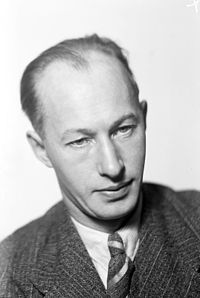Eyvind Johnson
You can helpexpand this article with text translated fromthe corresponding articlein Swedish.(October 2015)Click [show] for important translation instructions.
|
Eyvind Johnson | |
|---|---|
 Eyvind Johnson | |
| Born | Olof Edvin Verner Jonsson 29 July 1900 Boden,Sweden |
| Died | 25 August 1976(aged 76) Stockholm,Sweden |
| Period | 1924–1976 |
| Notable works | |
| Notable awards | Nobel Prize in Literature 1974 (shared withHarry Martinson) |
| Spouses |
|
| Children | 3 |
| Website | |
| www | |
Eyvind Johnson(29 July 1900 – 25 August 1976) was a Swedish novelist and short story writer. Regarded as the most groundbreaking novelist in modern Swedish literature[1]he became a member of theSwedish Academyin 1957 and shared the1974 Nobel Prize in LiteraturewithHarry Martinsonwith the citation:for a narrative art, far-seeing in lands and ages, in the service of freedom.[2]
Biography
[edit]Johnson was born Olof Edvin Verner Jonsson inSvartbjörnsbynvillage inÖverluleåparish, near the town ofBodeninNorrbotten.The small house where he was born is preserved and marked with a commemorative plaque.
Johnson left school at the age of thirteen and then held various jobs such aslog drivingand working at asaw milland as a ticket-seller and projectionist in acinema.In 1919 he left his hometown and moved toStockholmwhere he began to publish articles inanarchistmagazines likeBrand.In Stockholm he became friends with other youngproletarian writersand started the magazineVår nutid.He travelled in Germany in the 1920s and lived inSaint-Leu-la-Foret,nearParis,France, between 1927 and 1930 with his wifeAase Christoffersen(1900–1938). At this point he had published his first books. The firstDe fyra främlingarna,a collection of short stories, was published in 1924. Influenced by writers such asMarcel Proust,André GideandJames Joyce,Johnson gradually took distance from the traditional novel and became the most important representative ofmodernist literaturein Sweden. Johnson's early novels were not widely read, but his 1929 novelKommentar till ett stjärnfall( "Comment on a falling star" ), an attack oncapitalist society,was a critical success.[3]
Johnson's first major success as a writer was fourautobiographical novelspublished between 1934 and 1937, published together asRomanen om Olof( "The Novel about Olof" ), about a young man growing up in the northern parts of Sweden. In the novels Johnson blended realism with fairy tales and typical modernist features such asinner monologueand changingpoint of view.Romanen om Olofbecame aclassicin Swedish literature and was later filmed asHere Is Your Life.[3]
Increasingly upset by the rising totalitarianism in the 1930s, Johnson was strongly againstfascismandnazism.[3]DuringWorld War IIhe was editor of the magazineHåndslagand publishedKrilon,a trilogy of novels that in the form of anallegorydeals with the events during the war. In the novels Johnson condemns Nazi oppression and criticises the controversialSwedish neutrality policyduring the war.[3]Krilonis considered to be one of Johnson's best works.[4][5]In the same period he was a member of the nationalist associationSamfundet Nordens Frihetand among the contributors of its magazine,Nordens Frihet.[6]
In 1946 he published one of his most famous novels,Return to Ithaca(Strändernas svall), based on the story ofOdysseusas he returns to Ithaca after the Trojan war. Johnson married translatorCilla Johnsonin 1940. He lived with his family in Switzerland 1947–1949 and then a year in England. Travels to Italy and France inspired him to write several well-receivedhistorical novels.Among the best known areDreams of Roses and Fire(Drömmar om rosor och eld,1949) set inCardinal Richelieus17th century France, andMolnen över Metapontion( "The Clouds above Metapontion", 1957) that typically for his later novels switches back and forth between different time levels. In 1957 he was elected a member of theSwedish Academy.
Johnson has nominated the Nobel laurateGiorgos Seferistwice for a Nobel in literature in 1962 and in 1963,[7]which Seferis won.
Johnson's most noted works internationally includeReturn to IthacaandThe Days of His Grace(Hans nådes tid,1960) which have been translated to many languages. For the latter novel Johnson was awarded theNordic Council Literature Prizein 1962.[8]
Works
[edit]Novels
[edit]- Timans och rättfärdigheten(1925)
- Stad i mörker(1927)
- Stad i ljus(1928)
- Minnas(1928)
- Kommentar till ett stjärnfall(1929)
- Avsked till Hamlet(1930)
- Bobinack(1932)
- Regn i gryningen(1933)
- Romanen om Olof(1934-1937, published together in 1945)
- Nu var det 1914(1934)
- Här har du ditt liv!(1935)
- Se dig inte om!(1936)
- Slutspel i ungdomen(1937)
- Nattövning(1938)
- Soldatens återkomst(1940)
- Krilon(1941-1943, published together in 1948)
- Grupp Krilon(1941)
- Krilons resa(1942)
- Krilon själv(1943)
- Return to Ithaca(Swedish:Strändernas svall,1946)
- Dreams of Roses and Fire(Drömmar om rosor och eld,1949)
- Lägg undan solen(1951)
- Romantisk berättelse(1953)
- Tidens gång(1955)
- Molnen över Metapontion(1957)
- The Days of His Grace(Swedish:Hans nådes tid,1960)
- Livsdagen lång(1964)
- Favel ensam(1968)
- Några steg mot tystnaden(1973)
- Herr Clerk vår mästare(original version ofMinnas,novel, 1998)
Short story collections
[edit]- De fyra främlingarna(1924)
- Natten är här(1932)
- Än en gång, kapten!(1934)
- Den trygga världen(1940)
- Sju liv(1944)
- Pan mot Sparta(1946)
- Olibrius och gestalterna(1986)
Plays
[edit]- Return to Ithaca(Swedish:Strändernas svall,1948)
Nonfiction
[edit]- Dagbok från Schweiz(1949)
- Vinterresa i Norrbotten(1955)
- Vägar över Metaponto – en resedagbok(1959)
- Spår förbi Kolonos – en berättelse(1961)
- Stunder, vågor – anteckningar, berättelser(1965)
- Resa i hösten 1921(1973)
References
[edit]- ^Svenska Akademien
- ^Brandsma, Elliott (2021)."Recovering a" Lost Europe ": The De-Centering of Master Narratives in Eyvind Johnson's Natten är här".Humanities.10:46.doi:10.3390/h10010046.
- ^abcdPetri LiukonnenEyvind JohnsonBooks and writers
- ^Örjan LindbergerMänniskan i tiden: Eyvind Johnsons liv och författarskap 1938-1976,Bonniers 1990ISBN91-0-047904-7,p. 134
- ^Gavin OrtonEyvind Johnson. En monografiAldus 1974ISBN91-0-039665-6,p. 73
- ^"Antinazister och nordister under andra världskriget"(in Swedish). forskning.se. 11 September 2009.Retrieved7 March2022.
- ^"Nomination Archive".NobelPrize.org.1 April 2020.Retrieved3 January2024.
- ^Nordic Council Literature Prize
External links
[edit]- Eyvind Johnson Society
- Eyvind Johnsonon Nobelprize.org
- 1900 births
- 1976 deaths
- People from Boden Municipality
- Writers from Norrbotten
- Harry Martinson
- 20th-century Swedish novelists
- Nobel laureates in Literature
- Swedish-language writers
- Members of the Swedish Academy
- Nordic Council Literature Prize winners
- Swedish Nobel laureates
- Dobloug Prize winners
- Swedish male novelists
- Swedish historical novelists
- Swedish short story writers
- Male short story writers
- 20th-century short story writers
- Swedish magazine founders

